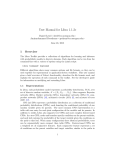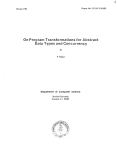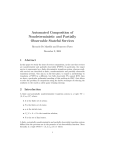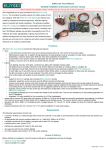Download SDD Beginning-User Manual Version 1.1
Transcript
SDD Beginning-User Manual Version 1.1 Arthur Choi and Adnan Darwiche Automated Reasoning Group Computer Science Department University of California, Los Angeles Email: [email protected] Download: http://reasoning.cs.ucla.edu/sdd November 7, 2013 The Sentential Decision Diagram (SDD) is a canonical representation of Boolean functions. The SDD package, which is distributed as a C library called libsdd, allows users to construct, manipulate and optimize SDDs. This manual describes the basics of the SDD package, meant for users who are interested in immediately constructing SDDs and performing queries on them. An advanced user’s manual is also provided for those users interested in more fine-grained access to some of the library’s features. The license terms for the SDD package are given at the end of this manual. 1 3 ¬B 5 D C C 1 ¬D⊥ B ¬A ¬B⊥ ⊤ 1 B A ¬B⊥ Figure 1: A graphical depiction of an SDD, for the Boolean function f = (A ∧ B) ∨ (B ∧ C) ∨ (C ∧ D). 1 Introduction The Sentential Decision Diagram (SDD) is a recently proposed representation of Boolean functions [1, 2, 3]. The SDD can be thought of as a “data structure” for representing Boolean functions, since SDDs are canonical and support a number of efficient operations for constructing and manipulating Boolean functions. Figure 1 depicts an example SDD and the Boolean function it represents. This manual provides a brief introduction to the SDD library, using a small set of library functions, which are sufficient to do the following: – Construct complex SDDs from elementary SDDs, corresponding to constants or literals. – Manipulate and query SDDs. – Read/write SDDs from/to a file. – Visualize SDDs, as in Figure 1. An advanced manual is available for those users who want a richer interface, with access to more of the machinery underlying the SDD library. 2 SDDs Consider again Figure 1, which contains a graphical depiction of a Sentential Decision Diagram (SDD), along with the Boolean function that the SDD represents. There are two types of nodes here: circle nodes are called decision nodes, and paired boxes p s are called elements. A decision node represents a disjunction of its child elements, and a paired box p s represents a conjunction p ∧ s, where a box can contain either a pointer to a decision node, a constant (> for true, and ⊥ for false), or a literal (X or ¬X). Each node and paired box then corresponds to some sub-function of the SDD, with the root node representing the function itself. For example, in the bottom row of paired boxes, we have, from left-to-right, the corresponding functions: D ∧ C, ¬D ∧ ⊥ = ⊥, B ∧ ¬A, etc. In the lower row of circular nodes, we have, from left-to-right, the corresponding functions: (D ∧ C) ∨ (¬D ∧ ⊥) = C ∧ D (B ∧ ¬A) ∨ (¬B ∧ ⊥) = ¬A ∧ B (B ∧ A) ∨ (¬B ∧ ⊥) = A ∧ B. The root node of the SDD represents the Boolean function: f = [¬B ∧ (C ∧ D)] ∨ [(¬A ∧ B) ∧ C] ∨ [(A ∧ B) ∧ >] = (A ∧ B) ∨ (B ∧ C) ∨ (C ∧ D). 2 A 1 B 2 C Figure 2: A simple circuit consisting of two inverters, labeled 1 and 2, and three wires, labeled A, B and C. SDDs are structured representations of Boolean functions, which allow certain operations to be performed efficiently (in practice, if not also in theory). For example, one can conjoin and disjoin two SDDs efficiently. One can also, for example, perform model counting in time that is linear in the size of the SDD. For more on SDDs, including theoretical and practical comparisons with OBDDs, see [1, 2, 3]. 3 Preliminaries In the next section, we shall highlight the core components of the SDD library, using a running example based on a diagnostic application. The source code for this example is included in the SDD package, and also in Appendix A. We will start though by showing how to compile a program with the SDD library. 3.1 The Header File The functions and types used in the SDD library are declared in the header file sddapi.h. This manual, however, is based on a small subset of the functions declared in this file. We call this the core API and summarize it in Appendix C. 3.2 Compiling To compile the examples in this manual, under Linux, one can save a code sample (say from Section A) to a file circuit.c, in a directory which contains (1) a subdirectory include containing the header file sddapi.h, and (2) a subdirectory lib including the library file libsdd.a. Compile the code using the command: gcc -O2 -std=c99 circuit.c -Iinclude -Llib -lsdd -lm -o circuit Executing the command circuit will then run the program. The sample program outputs .dot files in an output sub-directory (which must also exist in the current directory). These files can be converted to graphs using the GraphViz dot program. 4 Diagnosing Failures in Digital Circuits Consider Figure 2, which depicts a simple digital circuit, consisting of two inverters, labeled 1 and 2, and three wires, labeled A, B and C. 3 We can specify a knowledge base modeling this ¬faulty1 faulty1 ∆= ¬faulty2 faulty2 digital circuit, using propositional logic: ⇒ ⇒ A ⇔ ¬B (A ⇔ B) ∨ ¬B ⇒ ⇒ B ⇔ ¬C (B ⇔ C) ∨ ¬C The knowledge base ∆ is composed of four sentences, two sentences for each inverter. The first sentence specifies the normal operating behavior of an inverter: the output of an inverter is the complement of its input. The second sentence specifies the behavior of an inverter when it is faulty: either it behaves as a buffer (the output value is the same as the input), i.e., A ⇔ B, or it behaves as if it is fixed to low, i.e., ¬B. Variables faulty1 and faulty2 are called health variables, and a term over all health variables is called a health state. For example, faulty1 ∧ ¬faulty2 is a health state where inverter 1 is faulty and inverter 2 is healthy. Given an (abnormal) observation about the system, e.g., A ∧ ¬C, we would like to reason about the health states that are consistent with that observation. Any such health state is further called a diagnosis. 5 The SDD Library In this section, we will highlight the core components of the SDD library, using a running example for the diagnostic application we just discussed. In particular, we will show how to construct an SDD that represents the knowledge base ∆. We will then show how to manipulate this SDD to obtain answers to diagnostic queries. 5.1 The SDD Manager The construction and manipulation of SDDs is done via an SDD manager. Hence, a typical program using the SDD library will have the following structure, where the first thing to do is create an SDD manager, and the last thing to do is free the manager: #include <stdio.h> #include <stdlib.h> #include "sddapi.h" int main(int argc, char** argv) { // initialize manager SddLiteral var_count = 5; // initial number of variables int auto_gc_and_minimize = 0; // disable (0) or enable (1) auto-gc & auto-min SddManager* manager = sdd_manager_create(var_count,auto_gc_and_minimize); // CONSTRUCT, MANIPULATE AND QUERY SDDS // ... // free manager sdd_manager_free(manager); return 0; } An SDD manager keeps track of all its associated SDDs. Hence, by freeing the SDD manager, one also frees the memory of all SDDs created within that manager. 4 When we create an SDD manager, we declare an (initial) number of variables, var count. We also disable or enable automatic garbage collection and SDD minimization. In our example, we have created a new SDD manager, declaring that we want to have 5 variables. We have further disabled automatic garbage collection and SDD minimization. Some degree of memory management is integral for the construction of SDDs in practical applications. In the SDD library, memory management is based on garbage collection with reference counting. We will, however, delay this discussion until Section 6 to simplify our introduction to the SDD library. This is why we have disabled automatic garbage collection and SDD minimization for now. 5.2 Variables, Literals and Elementary SDDs In the SDD library, variables are referred to by indices. Since our manager has five variables, their indices will be 1, 2, 3, 4 and 5. Literals are referred to by signed indices. For example, the third variable has a positive literal 3 and a negative literal −3. The variables of our diagnosis example are A, B, C, faulty1 and faulty2 . In the code snippet below, we associate each one of these variables with an index from 1 to 5: SddLiteral A = 1, B = 2, C = 3, faulty1 = 4, faulty2 = 5; Here, SddLiteral is an integer type that is defined by the SDD library, in the header file sddapi.h. This type is used to specify literals: variables or their negation. The SDD manager maintains a unique SDD for each constant and literal. To access these elementary SDDs, we have the three functions: SddNode* sdd_manager_true(const SddManager* manager); SddNode* sdd_manager_false(const SddManager* manager); SddNode* sdd_manager_literal(const SddLiteral literal, SddManager* manager); We next illustrate how we can use the SDDs returned by these functions to create more complex SDDs. 5.3 Constructing SDDs from Elementary SDDs Our goal here is to construct an SDD representing ¬faulty1 faulty1 ∆= ¬faulty 2 faulty2 the following knowledge base: ⇒ ⇒ ⇒ ⇒ A ⇔ ¬B (A ⇔ B) ∨ ¬B B ⇔ ¬C (B ⇔ C) ∨ ¬C We can construct each of the four sentences from elementary SDDs, one at a time. We can then compose these four sentences together, giving us an SDD for the knowledge base ∆. We start with a vacuous knowledge base, represented by a true SDD: SddNode* delta = sdd_manager_true(manager); Using the following functions, we can conjoin two SDDs, disjoin two SDDs, or negate an SDD: SddNode* sdd_conjoin(SddNode* node1, SddNode* node2, SddManager* manager); SddNode* sdd_disjoin(SddNode* node1, SddNode* node2, SddManager* manager); SddNode* sdd_negate(SddNode* node, SddManager* manager); Using these functions as primitives, we can create our own functions that perform other operations on SDDs. For example, given an SDD representing a function α and an SDD representing a function β, we can construct an SDD representing the sentence α ⇒ β, which is logically equivalent to ¬α ∨ β: 5 SddNode* sdd_imply(SddNode* node1, SddNode* node2, SddManager* manager) { return sdd_disjoin(sdd_negate(node1,manager),node2,manager); } Using the above function as a primitive, we can construct an SDD representing the sentence α ⇔ β, which is logically equivalent to (α ⇒ β) ∧ (β ⇒ α): SddNode* sdd_equiv(SddNode* node1, SddNode* node2, SddManager* manager) { return sdd_conjoin(sdd_imply(node1,node2,manager), sdd_imply(node2,node1,manager),manager); } We are now prepared to construct an SDD for our knowledge base ∆. Let us first construct an SDD for the sentence: ¬faulty1 ⇒ (A ⇔ ¬B). We can first construct the SDD for the sub-sentence A ⇔ ¬B, using the SDDs for literals A and ¬B. We then take the resulting SDD, and combine it with the SDD for literal ¬faulty1 , as we do in the following code snippet: SddNode* alpha; alpha = sdd_equiv(sdd_manager_literal(A,m),sdd_manager_literal(-B,m),m); alpha = sdd_imply(sdd_manager_literal(-faulty1,m),alpha,m); where we have used the abbreviated name m for the SDD manager. We then conjoin this sentence with the SDD for our knowledge base (which we initialized to true): delta = sdd_conjoin(delta,alpha,m); We can construct SDDs for each sentence similarly, conjoining each with our knowledge base. For example, the following code snippet constructs an SDD for the sentence faulty1 ⇒ [(A ⇔ B) ∨ ¬B], and conjoins it with the SDD for our knowledge base: alpha alpha alpha delta = = = = sdd_equiv(sdd_manager_literal(A,m),sdd_manager_literal(B,m),m); sdd_disjoin(alpha,sdd_manager_literal(-B,m),m); sdd_imply(sdd_manager_literal(faulty1,m),alpha,m); sdd_conjoin(delta,alpha,m); Once we have incorporated all sentences, we can start performing queries on our model, using the final SDD that we constructed. 5.4 Querying SDDs Given an SDD representation of our knowledge base ∆, we can begin to assert observations in our model, and make inferences about them. In our diagnosis example, we would like to observe some system behavior, and then diagnose the possible faults. First, we can condition an SDD on a literal, using the following function: SddNode* sdd_condition(SddLiteral lit, SddNode* node, SddManager* manager); For example, we can assert the observation that input A is high, and output C is low: delta = sdd_condition(A,delta,m); delta = sdd_condition(-C,delta,m); 6 Conditioning a knowledge base ∆ on a literal X, denoted by ∆|X, replaces each instance of literal X in ∆ by true, and each instance of literal ¬X in ∆ by false. Analogously, conditioning ∆ on a literal ¬X, denoted by ∆|¬X, replaces X by false and ¬X by true. In our example, the SDD for (∆|A)|¬C is then: 3 ¬B faulty₂ B faulty₁ First, we want to test whether our observation A ∧ ¬C is normal (all components can be healthy) or abnormal (there exists a fault). In particular, we want to test if the sentence ∆ ∧ (A ∧ ¬C) ∧ (¬faulty1 ∧ ¬faulty2 ) is consistent or inconsistent. SddNode* gamma; gamma = sdd_condition(-faulty1,delta,m); gamma = sdd_condition(-faulty2,gamma,m); int is_abnormal = sdd_node_is_false(gamma); If the resulting SDD gamma is false, then our observations are abnormal; otherwise, they are normal. We can test whether a given SDD is false or true, using the following functions: int sdd_node_is_false(SddNode* node); int sdd_node_is_true(SddNode* node); These functions return 1 if the given SDD node corresponds to the one being queried, and 0 otherwise. Next, to compute our diagnoses, we project our SDD onto the health variables faulty1 and faulty2 . In particular, we existentially quantify out all non-health variables, which is just variable B in this case: SddNode* diagnosis = sdd_exists(B,delta,m); Given a knowledge base ∆ and a variable X, existential quantification is more formally defined as ∃X∆ = ∆|X ∨ ∆|¬X. Similarly, universal quantification is defined as ∀X∆ = ∆|X ∧ ∆|¬X. The corresponding functions are used to existentially and universally quantify out a variable from an SDD: SddNode* sdd_exists(SddLiteral var, SddNode* node, SddManager* manager); SddNode* sdd_forall(SddLiteral var, SddNode* node, SddManager* manager); In our diagnosis example, we obtain the following SDD, representing our diagnoses: 7 ¬faulty₁ faulty₂ faulty₁ ⊤ This SDD corresponds to the sentence (¬faulty1 ∧ faulty2 ) ∨ faulty1 , which has three models: faulty1 ¬faulty1 faulty1 ∧ ∧ ∧ ¬faulty2 faulty2 faulty2 . Often, we are interested in the minimum cardinality diagnoses: ones with a minimal number of faults. The SDD package supports this type of query as well: SddNode* min_diagnosis = sdd_minimize_cardinality(diagnosis,m); 7 More generally, the cardinality of a model is the number of positive literals that appear in the model. The models of the SDD returned by sdd minimize cardinality are precisely the minimum cardinality models of the input SDD. In our example, this function gives the following SDD: 7 faulty₁ ¬faulty₂ ¬faulty₁ faulty₂ which represents the sentence (faulty1 ∧ ¬faulty2 ) ∨ (¬faulty1 ∧ faulty2 ). The SDD library provides a function for counting the models of an SDD. For example, the following code snippet counts the number of diagnoses and minimum-cardinality diagnoses in our example. SddModelCount count = sdd_model_count(diagnosis,m); SddModelCount min_count = sdd_model_count(min_diagnosis,m); Here, we have 3 diagnoses, and 2 minimum-cardinality diagnoses. The functions sdd model count, sdd minimum cardinality, and sdd minimize cardinality are with respect to the variables that a given SDD essentially depends on. More formally, we say that a Boolean function f (and analogously, an SDD) essentially depends on a variable X iff f |X 6= f |¬X. We can see what variables an SDD depends on using the function: int* sdd_variables(SddNode* node, SddManager* manager); If an SDD manager is associated with n variables, then function sdd variables returns an array of length n + 1, where the i-th entry is 1 if the SDD essentially depends on the i-th variable and 0 otherwise. The 0-th entry is unused. Suppose that we had observed wires A and B to be high. If we condition our knowledge base on this observation, and then existentially quantify out variable C, we get faulty1 . Calling sdd minimize cardinality on this result also returns faulty1 . However, the minimum-cardinality diagnoses (with respect to variables faulty1 and faulty2 ) is faulty1 ∧ ¬faulty2 . As the function representing our diagnoses does not essentially depend on variable faulty2 , we should compensate for the absence of faulty2 in terms of the model count and minimum cardinality models. For model counting, we can multiply the model count obtained by 2 for each missing variable. For minimum cardinality models, we can conjoin the corresponding negative literal, for each missing variable. We perform such a check in our example in Appendix A. 5.5 File I/O We can save any SDD that we create to a file. For example, the following code snippet saves the SDD representing our minimum-cardinality diagnoses to a file called diagnosis-min.sdd: sdd_save("diagnosis-min.sdd",min_diagnosis); The SDD file format is a simple text format, which is described in the file itself. The file can be read in again using the code snippet: SddLiteral var_count = 5; SddManager* manager = sdd_manager_create(var_count); SddNode* sdd = sdd_read("diagnosis-min.sdd",manager); To use the function sdd read, we need an SDD manager with a variable count that is large enough to cover all variables mentioned by the saved SDD. The SDD library also allows us to visualize SDDs via the graph drawing system GraphViz (available at http://www.graphviz.org/). The SDDs illustrated in this manual were indeed generated by the dot program. The following code snippet saves an SDD to dot format: 8 sdd_save_as_dot("diagnosis-min.dot",min_diagnosis); We can then use the dot program to generate a graphical depiction of the SDD, as a PNG image file, using the following command: dot -Tpng -odiagnosis-min.png diagnosis-min.dot Note that, in the generated graphs, variables with indices from 1 to 26 are mapped to letters from A to Z. Higher indices simply have their index printed. 6 Garbage Collection While constructing and manipulating SDDs, one may construct many intermediate SDDs that are used once, but can subsequently be discarded. The SDD library itself produces auxiliary SDDs to perform certain operations. For sufficiently complex programs, these auxiliary SDDs will eventually exhaust a system’s memory unless garbage collected. The SDD library includes a garbage collector which is based on reference counts. SDD nodes can be referenced and dereferenced using the following functions: void sdd_ref(SddNode* node, SddManager* manager); void sdd_deref(SddNode* node, SddManager* manager); Any SDD node that is not currently referenced is subject to garbage collection, which can be invoked manually, or automatically by the SDD library as needed. We will restrict our discussion here to automatic garbage collection, leaving manual garbage collection to the advanced-user manual. Automatic garbage collection can be activated by creating an SDD manager as follows: int auto_gc_and_minimize = 1; // disable (0) or enable (1) auto-gc & auto-min SddManager* manager = sdd_manager_create(var_count,auto_gc_and_minimize); When automatic garbage collection is activated, the SDD library will occasionally try to minimize the size of existing SDDs (an operation that is distinct from cardinality minimization, which we discussed in the previous section). Hence, the structure of SDDs (which can be visualized using dot) may change over time, although the logical content of such SDDs will remain the same. In the example from Section 5, we can reference any SDD node as soon as soon as it is created. We can also dereference an SDD node as soon as we know that we will no longer use it. We can do this in a systematic way, line-by-line. Consider the following code snippet, where we construct the first sentence of our knowledge base ∆: SddNode* delta = sdd_manager_true(m); SddNode* alpha; alpha = sdd_equiv(sdd_manager_literal(A,m),sdd_manager_literal(-B,m),m); alpha = sdd_imply(sdd_manager_literal(-faulty1,m),alpha,m); delta = sdd_conjoin(delta,alpha,m); For each function that returns an SDD, we will immediately reference the returned SDD. Moreover, after we obtain that SDD, we will dereference any SDD used to construct it, if we know that it will be the last time we need to use that SDD. It is not necessary, however, to reference or dereference elementary SDDs, i.e., the SDDs for true, false and for literals. These SDDs will never be garbage collected. Moreover, referencing and dereferencing them has no effect. First, we reference the SDD returned by the function sdd equiv: 9 alpha = sdd_equiv(sdd_manager_literal(A,m),sdd_manager_literal(-B,m),m); sdd_ref(alpha,m); We do not need to reference or dereference any of the input SDDs here, as they are SDDs for literals. Next, we want to reference the SDD returned by the function sdd imply. However, we will want to dereference the input SDD that was returned by sdd equiv, as we will no longer need it after calling sdd imply. SddNode* tmp; alpha = sdd_imply(sdd_manager_literal(-faulty1,m),tmp = alpha,m); sdd_ref(alpha,m); sdd_deref(tmp,m); Here, we have used a temporary pointer tmp to save the address of the input SDD alpha. Finally, we reference the SDD returned by function sdd conjoin. delta = sdd_conjoin(delta,alpha,m); sdd_ref(delta,m); sdd_deref(alpha,m); Here, we have dereferenced the input alpha, which we will again no longer need. Note that we do not need to dereference the input delta, since it corresponds to the SDD for true, which never needs to be dereferenced. Consider the following code snippet from the previous section, where we constructed the second sentence of our knowledge base ∆: alpha alpha alpha delta = = = = sdd_equiv(sdd_manager_literal(A,m),sdd_manager_literal(B,m),m); sdd_disjoin(alpha,sdd_manager_literal(-B,m),m); sdd_imply(sdd_manager_literal(faulty1,m),alpha,m); sdd_conjoin(delta,alpha,m); we can also systematically augment this snippet, line-by-line, in a similar way. alpha = sdd_equiv(sdd_manager_literal(A,m),sdd_manager_literal(B,m),m); sdd_ref(alpha,m); alpha = sdd_disjoin(tmp = alpha,sdd_manager_literal(-B,m),m); sdd_ref(alpha,m); sdd_deref(tmp,m); alpha = sdd_imply(sdd_manager_literal(faulty1,m),tmp = alpha,m); sdd_ref(alpha,m); sdd_deref(tmp,m); delta = sdd_conjoin(tmp = delta,alpha,m); sdd_ref(delta,m); sdd_deref(tmp,m); sdd_deref(alpha,m); Appendix A contains the complete circuit diagnosis example, where we have systematically incorporated referencing and dereferencing in the same way: reference any SDD returned by a call to the library (or a call to a function that calls the library), and dereference any input SDDs that are no longer needed. One can check the reference count of an SDD node using the following function: SddRefCount sdd_ref_count(SddNode* node); This can be useful for debugging purposes. To aid further with debugging, the following functions are provided by the SDD library. SddId sdd_id(SddNode* node); int sdd_garbage_collected(SddNode* node, SddSize id); 10 Every SDD node is assigned a unique ID when created. Moreover, when an SDD node is garbage collected, its structure is not freed. Instead, it is added to a special list, called the gc-list, allowing this structure to be reused for newly created SDD nodes. When this structure is reused though, it will be assigned a new ID. Hence, to test whether a node has been garbage collected, one must supply both a pointer to the node and its ID. The following code snippet shows how to test whether a node has been garbage collected. SddId id = sdd_id(alpha); // ... // CONSTRUCT, MANIPULATE AND QUERY SDDS // ... if(sdd_garbage_collected(alpha,id)) { //alpha has been garbage collected } 7 Beyond the Manual This manual covered only the core concepts for getting started with the SDD library. The advanced-user manual covers a number of additional topics that would become important for applications that require finer-grained control of the machinery underlying the SDD library. These include topics such as: • manual garbage collection and minimization: The function sdd manager create initializes an SDD manager that can perform automatic garbage collection and SDD minimization, by default. For certain applications, however, the user may want to have control on when garbage collection and minimization are invoked. The SDD library includes support for this, by providing primitives for manual garbage collection and SDD minimization. • vtrees and vtree search: A vtree is a full, binary tree with its leaves labeled with variables. Every SDD manager has a vtree associated with it, which also determines the size and structure of its SDDs. The SDD library includes functions for specifying these vtrees. It also includes functions which allow the user to search for good vtrees (i.e., ones that try to minimize the size of corresponding SDDs). The SDD package comes with its own algorithm for vtree search. The source code of this algorithm is distributed with the package. Acknowledgements Special thanks to the members of the Automated Reasoning Group at UCLA, and, in particular, to Guy Van den Broeck for many helpful suggestions. References [1] A. Darwiche, “SDD: A new canonical representation of propositional knowledge bases,” in Proceedings of the 22nd International Joint Conference on Artificial Intelligence (IJCAI), pp. 819–826, 2011. [2] Y. Xue, A. Choi, and A. Darwiche, “Basing decisions on sentences in decision diagrams,” in Proceedings of the 26th Conference on Artificial Intelligence (AAAI), pp. 842–849, 2012. [3] A. Choi and A. Darwiche, “Dynamic minimization of sentential decision diagrams,” in Proceedings of the 27th AAAI Conference on Artificial Intelligence (AAAI), pp. 187–194, 2013. 11 A Code Sample (With Garbage Collection Disabled) #include <stdio.h> #include <stdlib.h> #include "sddapi.h" // returns an SDD node representing ( node1 => node2 ) SddNode* sdd_imply(SddNode* node1, SddNode* node2, SddManager* manager) { return sdd_disjoin(sdd_negate(node1,manager),node2,manager); } // returns an SDD node representing ( node1 <=> node2 ) SddNode* sdd_equiv(SddNode* node1, SddNode* node2, SddManager* manager) { return sdd_conjoin(sdd_imply(node1,node2,manager), sdd_imply(node2,node1,manager),manager); } int main(int argc, char** argv) { // set up vtree and manager SddLiteral var_count = 5; int auto_gc_and_minimize = 0; SddManager* m = sdd_manager_create(var_count,auto_gc_and_minimize); SddLiteral A = 1, B = 2, C = 3, faulty1 = 4, faulty2 = 5; SddNode* delta = sdd_manager_true(m); SddNode* alpha; ////////// CONSTRUCT KNOWLEDGE BASE ////////// // ~faulty1 => ( A <=> ~B ) alpha = sdd_equiv(sdd_manager_literal(A,m),sdd_manager_literal(-B,m),m); alpha = sdd_imply(sdd_manager_literal(-faulty1,m),alpha,m); delta = sdd_conjoin(delta,alpha,m); // faulty1 => ( ( A <=> B ) v ~B ) alpha = sdd_equiv(sdd_manager_literal(A,m),sdd_manager_literal(B,m),m); alpha = sdd_disjoin(alpha,sdd_manager_literal(-B,m),m); alpha = sdd_imply(sdd_manager_literal(faulty1,m),alpha,m); delta = sdd_conjoin(delta,alpha,m); // ~faulty2 => ( B <=> ~C ) alpha = sdd_equiv(sdd_manager_literal(B,m),sdd_manager_literal(-C,m),m); alpha = sdd_imply(sdd_manager_literal(-faulty2,m),alpha,m); delta = sdd_conjoin(delta,alpha,m); // faulty2 => ( ( B <=> C ) v ~C ) alpha = sdd_equiv(sdd_manager_literal(B,m),sdd_manager_literal(C,m),m); alpha = sdd_disjoin(alpha,sdd_manager_literal(-C,m),m); alpha = sdd_imply(sdd_manager_literal(faulty2,m),alpha,m); delta = sdd_conjoin(delta,alpha,m); ////////// PERFORM QUERY ////////// 12 int* variables; SddLiteral health_vars = 2, health_vars_count, missing_health_vars; // make observations delta = sdd_condition(A,delta,m); delta = sdd_condition(-C,delta,m); // check if observations are normal SddNode* gamma; gamma = sdd_condition(-faulty1,delta,m); gamma = sdd_condition(-faulty2,gamma,m); int is_abnormal = sdd_node_is_false(gamma); printf("observations normal? : %s\n", is_abnormal ? "abnormal":"normal"); // project onto faults SddNode* diagnosis = sdd_exists(B,delta,m); // diagnosis no longer depends on variables A,B or C // count the number of diagnoses SddModelCount count = sdd_model_count(diagnosis,m); // adjust for missing faults variables = sdd_variables(diagnosis,m); health_vars_count = variables[faulty1] + variables[faulty2]; missing_health_vars = health_vars - health_vars_count; count <<= missing_health_vars; // multiply by 2^missing_health_vars free(variables); // find minimum cardinality diagnoses SddNode* min_diagnosis = sdd_minimize_cardinality(diagnosis,m); variables = sdd_variables(min_diagnosis,m); // adjust for missing faults if ( variables[faulty1] == 0 ) min_diagnosis = sdd_conjoin(min_diagnosis,sdd_manager_literal(-faulty1,m),m); if ( variables[faulty2] == 0 ) min_diagnosis = sdd_conjoin(min_diagnosis,sdd_manager_literal(-faulty2,m),m) ; free(variables); // count the number of minimum cardinality diagnoses, and minimum cardinality SddModelCount min_count = sdd_model_count(min_diagnosis,m); SddLiteral min_card = sdd_minimum_cardinality(min_diagnosis); printf("sdd model count : %"PRImcS"\n",count); printf("sdd model count (min) : %"PRImcS"\n",min_count); printf("sdd cardinality : %"PRIlitS"\n",min_card); ////////// SAVE SDDS ////////// printf("saving sdd and dot ...\n"); sdd_save("output/circuit-kb.sdd",delta); sdd_save("output/diagnosis.sdd",diagnosis); sdd_save("output/diagnosis-min.sdd",min_diagnosis); sdd_save_as_dot("output/circuit-kb.dot",delta); sdd_save_as_dot("output/diagnosis.dot",diagnosis); sdd_save_as_dot("output/diagnosis-min.dot",min_diagnosis); 13 ////////// CLEAN UP ////////// sdd_manager_free(m); return 0; } 14 B Code Sample (With Garbage Collection Enabled) #include <stdio.h> #include <stdlib.h> #include "sddapi.h" // returns an SDD node representing ( node1 => node2 ) SddNode* sdd_imply(SddNode* node1, SddNode* node2, SddManager* manager) { SddNode* neg_node1 = sdd_negate(node1,manager); sdd_ref(neg_node1,manager); SddNode* alpha = sdd_disjoin(neg_node1,node2,manager); sdd_deref(neg_node1,manager); return alpha; } // returns an SDD node representing ( node1 <=> node2 ) SddNode* sdd_equiv(SddNode* node1, SddNode* node2, SddManager* manager) { SddNode* imply1 = sdd_imply(node1,node2,manager); sdd_ref(imply1,manager); SddNode* imply2 = sdd_imply(node2,node1,manager); sdd_ref(imply2,manager); SddNode* alpha = sdd_conjoin(imply1,imply2,manager); sdd_deref(imply1,manager); sdd_deref(imply2,manager); return alpha; } int main(int argc, char** argv) { // set up vtree and manager SddLiteral var_count = 5; int auto_gc_and_minimize = 1; SddManager* m = sdd_manager_create(var_count,auto_gc_and_minimize); SddLiteral A = 1, B = 2, C = 3, faulty1 = 4, faulty2 = 5; SddNode* delta = sdd_manager_true(m); SddNode* alpha; SddNode* tmp; ////////// CONSTRUCT KNOWLEDGE BASE ////////// // ~faulty1 => ( A <=> ~B ) alpha = sdd_equiv(sdd_manager_literal(A,m),sdd_manager_literal(-B,m),m); sdd_ref(alpha,m); alpha = sdd_imply(sdd_manager_literal(-faulty1,m),tmp = alpha,m); sdd_ref(alpha,m); sdd_deref(tmp,m); delta = sdd_conjoin(tmp = delta,alpha,m); sdd_ref(delta,m); sdd_deref(tmp,m); sdd_deref(alpha,m); // faulty1 => ( ( A <=> B ) v ~B ) alpha = sdd_equiv(sdd_manager_literal(A,m),sdd_manager_literal(B,m),m); sdd_ref(alpha,m); alpha = sdd_disjoin(tmp = alpha,sdd_manager_literal(-B,m),m); sdd_ref(alpha,m); sdd_deref(tmp,m); alpha = sdd_imply(sdd_manager_literal(faulty1,m),tmp = alpha,m); 15 sdd_ref(alpha,m); sdd_deref(tmp,m); delta = sdd_conjoin(tmp = delta,alpha,m); sdd_ref(delta,m); sdd_deref(tmp,m); sdd_deref(alpha,m); // ~faulty2 => ( B <=> ~C ) alpha = sdd_equiv(sdd_manager_literal(B,m),sdd_manager_literal(-C,m),m); sdd_ref(alpha,m); alpha = sdd_imply(sdd_manager_literal(-faulty2,m),tmp = alpha,m); sdd_ref(alpha,m); sdd_deref(tmp,m); delta = sdd_conjoin(tmp = delta,alpha,m); sdd_ref(delta,m); sdd_deref(tmp,m); sdd_deref(alpha,m); // faulty2 => ( ( B <=> C ) v ~C ) alpha = sdd_equiv(sdd_manager_literal(B,m),sdd_manager_literal(C,m),m); sdd_ref(alpha,m); alpha = sdd_disjoin(tmp = alpha,sdd_manager_literal(-C,m),m); sdd_ref(alpha,m); sdd_deref(tmp,m); alpha = sdd_imply(sdd_manager_literal(faulty2,m),tmp = alpha,m); sdd_ref(alpha,m); sdd_deref(tmp,m); delta = sdd_conjoin(tmp = delta,alpha,m); sdd_ref(delta,m); sdd_deref(tmp,m); sdd_deref(alpha,m); ////////// PERFORM QUERY ////////// int* variables; SddLiteral health_vars = 2, health_vars_count, missing_health_vars; // make observations and project onto faults delta = sdd_condition(A,tmp = delta,m); sdd_ref(delta,m); sdd_deref(tmp,m); delta = sdd_condition(-C,tmp = delta,m); sdd_ref(delta,m); sdd_deref(tmp,m); // check if observations are normal SddNode* gamma; gamma = sdd_condition(-faulty1,delta,m); sdd_ref(gamma,m); gamma = sdd_condition(-faulty2,tmp = gamma,m); sdd_ref(gamma,m); sdd_deref(tmp,m); int is_abnormal = sdd_node_is_false(gamma); printf("observations normal? : %s\n", is_abnormal ? "abnormal":"normal"); sdd_deref(gamma,m); // project onto faults SddNode* diagnosis = sdd_exists(B,delta,m); sdd_ref(diagnosis,m); // diagnosis no longer depends on variables A,B or C // count the number of diagnoses SddModelCount count = sdd_model_count(diagnosis,m); // adjust for missing faults variables = sdd_variables(diagnosis,m); health_vars_count = variables[faulty1] + variables[faulty2]; missing_health_vars = health_vars - health_vars_count; count <<= missing_health_vars; // multiply by 2^missing_health_vars free(variables); 16 // find minimum cardinality diagnoses SddNode* min_diagnosis = sdd_minimize_cardinality(diagnosis,m); sdd_ref(min_diagnosis,m); variables = sdd_variables(min_diagnosis,m); // adjust for missing faults if ( variables[faulty1] == 0 ) { min_diagnosis = sdd_conjoin(tmp = min_diagnosis,sdd_manager_literal(-faulty1,m),m); sdd_ref(min_diagnosis,m); sdd_deref(tmp,m); } if ( variables[faulty2] == 0 ) { min_diagnosis = sdd_conjoin(tmp = min_diagnosis,sdd_manager_literal(-faulty2,m),m); sdd_ref(min_diagnosis,m); sdd_deref(tmp,m); } free(variables); // count the number of minimum cardinality diagnoses, and minimum cardinality SddModelCount min_count = sdd_model_count(min_diagnosis,m); SddLiteral min_card = sdd_minimum_cardinality(min_diagnosis); printf("sdd model count : %"PRImcS"\n",count); printf("sdd model count (min) : %"PRImcS"\n",min_count); printf("sdd cardinality : %"PRIlitS"\n",min_card); ////////// SAVE SDDS ////////// printf("saving sdd and dot ...\n"); sdd_save("output/circuit-kb.sdd",delta); sdd_save("output/diagnosis.sdd",diagnosis); sdd_save("output/diagnosis-min.sdd",min_diagnosis); sdd_save_as_dot("output/circuit-kb.dot",delta); sdd_save_as_dot("output/diagnosis.dot",diagnosis); sdd_save_as_dot("output/diagnosis-min.dot",min_diagnosis); ////////// CLEAN UP ////////// sdd_manager_free(m); return 0; } 17 C SDD API (Core) Following are the core functions of the SDD library. The advanced-user manual describes the complete API. SDD Manager SddManager* sdd_manager_create(SddLiteral var_count, int auto_gc_and_minimize); void sdd_manager_free(SddManager* manager); Elementary SDDs SddNode* sdd_manager_true(const SddManager* manager); SddNode* sdd_manager_false(const SddManager* manager); SddNode* sdd_manager_literal(const SddLiteral literal, SddManager* manager); int sdd_node_is_true(SddNode* node); int sdd_node_is_false(SddNode* node); Queries and Transformations SddNode* sdd_conjoin(SddNode* node1, SddNode* node2, SddManager* manager); SddNode* sdd_disjoin(SddNode* node1, SddNode* node2, SddManager* manager); SddNode* sdd_negate(SddNode* node, SddManager* manager); SddNode* sdd_condition(SddLiteral lit, SddNode* node, SddManager* manager); SddNode* sdd_exists(SddLiteral var, SddNode* node, SddManager* manager); SddNode* sdd_forall(SddLiteral var, SddNode* node, SddManager* manager); SddModelCount sdd_model_count(SddNode* node); SddLiteral sdd_minimum_cardinality(SddNode* node); SddNode* sdd_minimize_cardinality(SddNode* node, SddManager* manager); int* sdd_variables(SddNode* node, SddManager* manager); File I/O void sdd_save(const char* fname, SddNode *node); void sdd_save_as_dot(const char* fname, SddNode *node); SddNode* sdd_read(const char* filename, SddManager* manager); Memory Management void sdd_ref(SddNode* node, SddManager* manager); void sdd_deref(SddNode* node, SddManager* manager); SddRefCount sdd_ref_count(SddNode* node); SddId sdd_id(SddNode* node); int sdd_garbage_collected(SddNode* node, SddSize id); 18 D License Copyright (c) 2013, Regents of the University of California All rights reserved. Redistribution and use in source and binary forms, with or without modification, are permitted provided that the following conditions are met: Redistributions of source code must retain the above copyright notice, this list of conditions and the following disclaimer. Redistributions in binary form must reproduce the above copyright notice, this list of conditions and the following disclaimer in the documentation and/or other materials provided with the distribution. Neither the name of the University of California nor the names of its contributors may be used to endorse or promote products derived from this software without specific prior written permission. THIS SOFTWARE IS PROVIDED BY THE COPYRIGHT HOLDERS AND CONTRIBUTORS "AS IS" AND ANY EXPRESS OR IMPLIED WARRANTIES, INCLUDING, BUT NOT LIMITED TO, THE IMPLIED WARRANTIES OF MERCHANTABILITY AND FITNESS FOR A PARTICULAR PURPOSE ARE DISCLAIMED. IN NO EVENT SHALL THE COPYRIGHT HOLDER OR CONTRIBUTORS BE LIABLE FOR ANY DIRECT, INDIRECT, INCIDENTAL, SPECIAL, EXEMPLARY, OR CONSEQUENTIAL DAMAGES (INCLUDING, BUT NOT LIMITED TO, PROCUREMENT OF SUBSTITUTE GOODS OR SERVICES; LOSS OF USE, DATA, OR PROFITS; OR BUSINESS INTERRUPTION) HOWEVER CAUSED AND ON ANY THEORY OF LIABILITY, WHETHER IN CONTRACT, STRICT LIABILITY, OR TORT (INCLUDING NEGLIGENCE OR OTHERWISE) ARISING IN ANY WAY OUT OF THE USE OF THIS SOFTWARE, EVEN IF ADVISED OF THE POSSIBILITY OF SUCH DAMAGE. 19






























